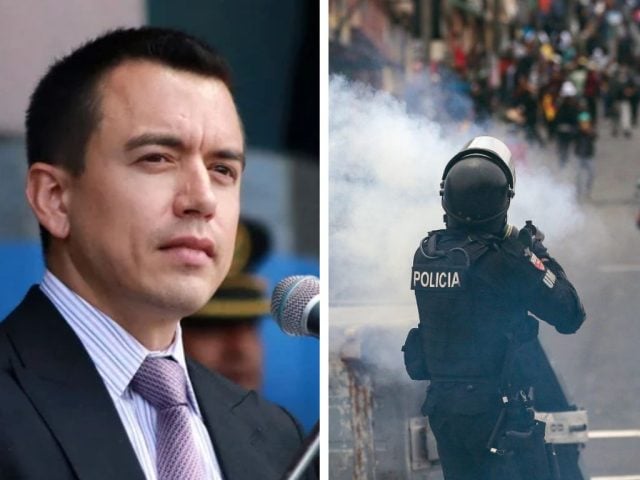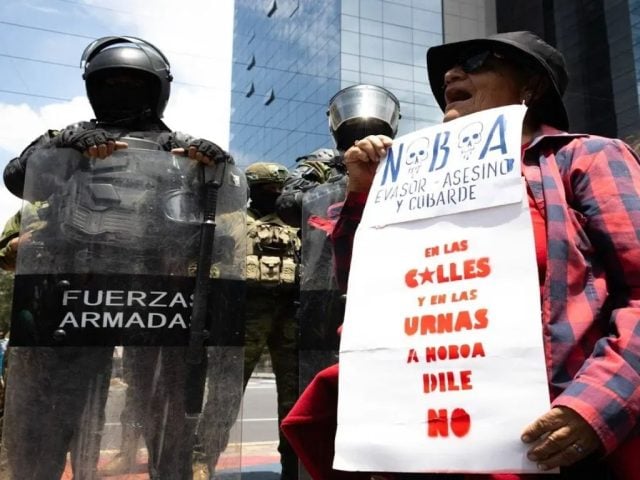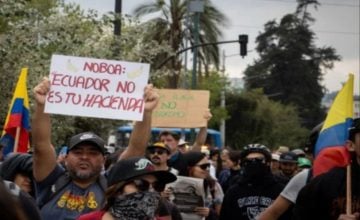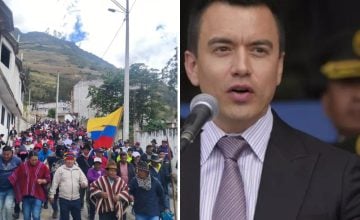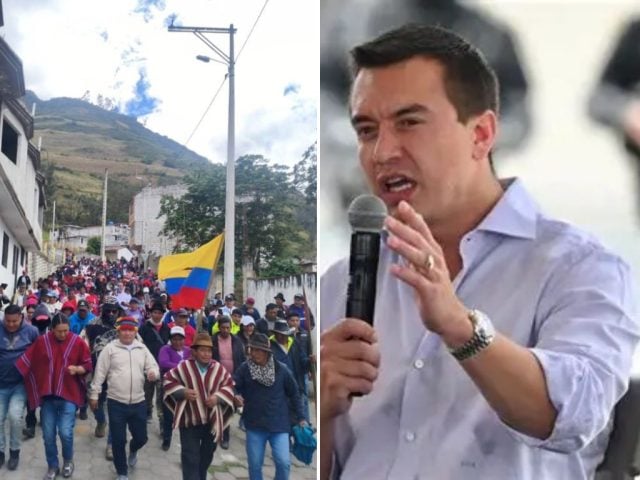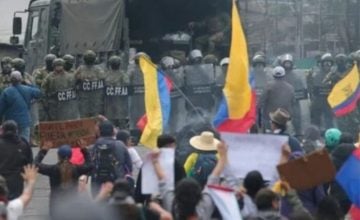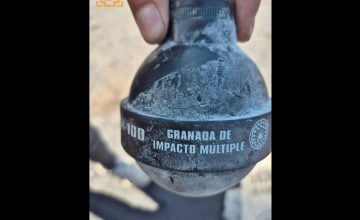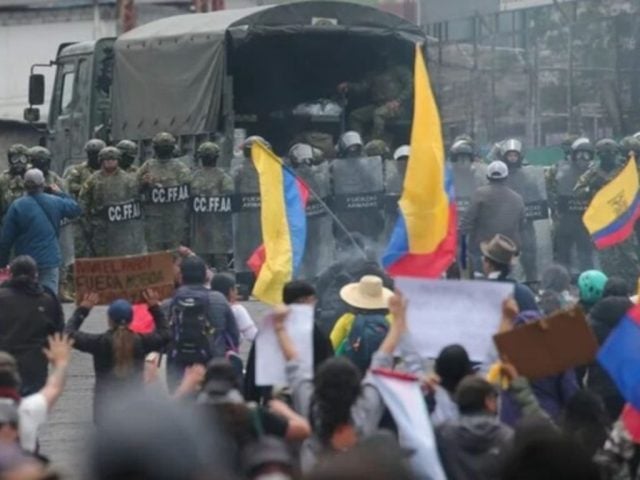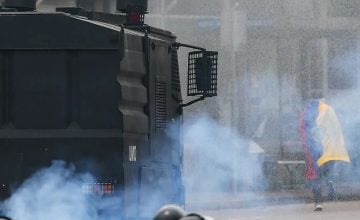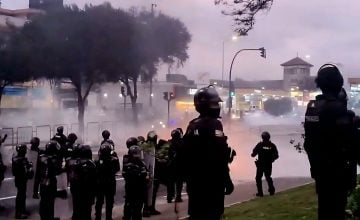Original article: Paro indígena en Ecuador cumple 25 días: 3 muertos, 15 desaparecidos y 282 heridos tras represión de Noboa
The excessive repression by state forces, ordered by the government of Daniel Noboa against mobilizations during Ecuador’s national strike, which has now reached 25 days, has resulted in a tragic toll, according to human rights organizations: 3 dead, 15 missing, 282 injured, and 172 arrests, amidst increasing violence from the president’s security forces.
The unrest began following the signing of Executive Decree 126 on September 12, through which the right-wing administration removed diesel subsidies and raised its price from $1.80 to $2.80 per gallon.
This price hike directly impacts transportation costs, agricultural production, and the household economies of many sectors, particularly indigenous and rural communities that rely on diesel for their productive activities and mobility. This situation prompted the Confederation of Indigenous Nationalities of Ecuador (CONAIE), alongside the Unified Workers Front (FUT), the National Coordinator of Students (CONAES), and other groups, to declare a state of permanent mobilization.
The protests also reject the shortage of medical supplies, the legalization of mining and oil extraction in national reserves— including the Galapagos—and systematic human rights violations since the declaration of the «Internal Armed Conflict» by the Noboa government.
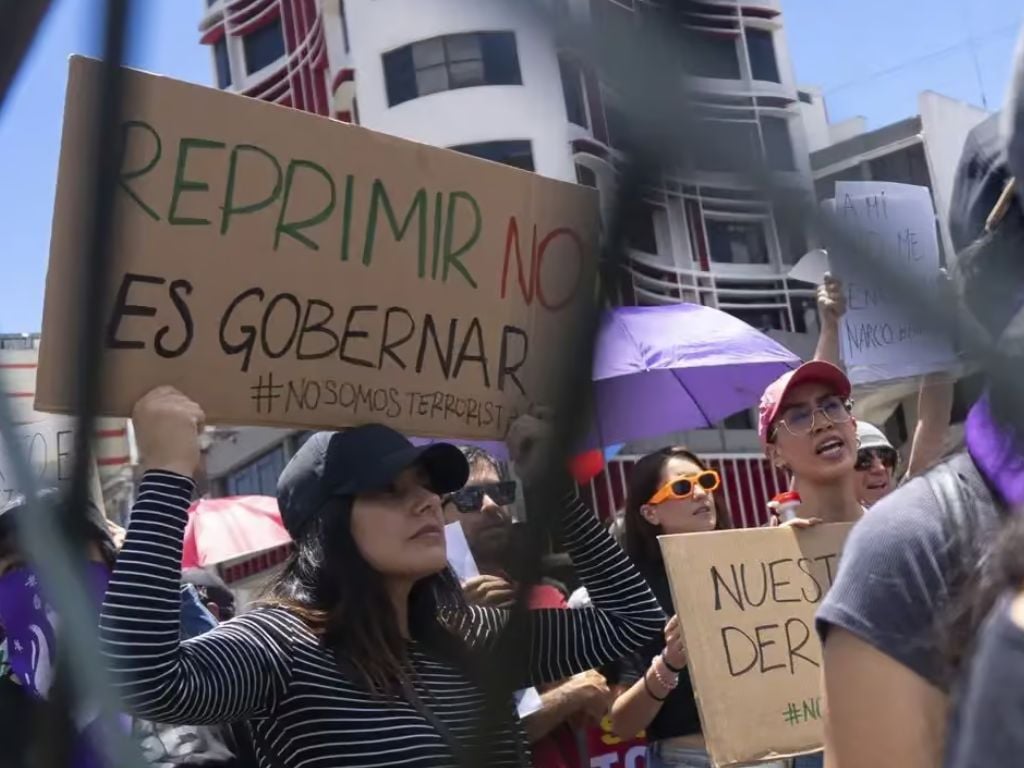
Timeline of a Crisis: From Protest to Repression
During this social and political conflict, the province of Imbabura in the northern Andes has emerged as the epicenter of resistance and mobilizations.
In response to the protests, Noboa’s approach has not been to open dialogue channels but to escalate the indiscriminate use of force and arbitrary arrests.
On October 11, he declared a new state of emergency in 10 provinces (Pichincha, Cotopaxi, Tungurahua, Chimborazo, Bolívar, Cañar, Azuay, Orellana, Sucumbíos, and Pastaza), citing «serious internal commotion» and claiming that the protests had become «violent.» This decree followed the Constitutional Court’s annulment of a previous decree on October 3, deeming it unconstitutional.
Throughout the 25 days of citizen mobilizations, operations by the National Police and Armed Forces have intensified, characterized by the disproportionate use of force, as documented by civil organizations.
The timeline of significant events clearly illustrates that Ecuador is experiencing states of repression.
– September 22: 12 community members are detained in Otavalo, accused of terrorism.
– September 28: The first reported death at the hands of Armed Forces personnel occurs. Kichwa leader Efraín Fuerez, 46, dies in Cotacachi from a projectile wound that fractured into four parts. Reports indicate that the shot entered his back and exited through his chest, leading to lung injuries and a cervical fracture.
– October 3: Repression intensifies against the Waranka people in Guaranda, with reports of assaults on women and arbitrary arrests.
– October 7: Indigenous protestors intercept President Noboa’s convoy during his visit to Cañar. Energy Minister Inés Manzano files a report for attempted murder, though a subsequent police report found no «ballistic evidence» on the vehicles, leading to the release of those detained.
– October 12: A massive mobilization in Quito for the Day of Interculturality is suppressed using tear gas and stun grenades in La Villaflora, El Ejido, and Avenida 6 de Diciembre. Reports of aggression against journalists and attempts to enter the Casa de la Cultura Ecuatoriana, where citizens sought refuge, are documented.
– October 13-14: A «humanitarian convoy» of military and police moves from Quito to Imbabura, while operations reported in Ibarra and other locations like Otavalo, Cotacachi, and Peguche are characterized by violence, arbitrary detentions, and military incursions into hospitals.
– October 15: The humanitarian crisis deepens with two new fatalities. Rosa Elena Paqui, 61, from the Kichwa Saraguro community, dies from respiratory failure after inhaling tear gas during confrontations in Loja. On the same day, José Guamán, a protestor from the Cachibiro community, is shot in the chest during a mobilization in Otavalo.
The National Strike Continues
In an attempt to defuse the crisis, a dialogue table was set up on October 15 in Otavalo between some indigenous leaders from Imbabura and the Noboa government.
Following negotiations, Mesías Flores, president of the Federation of Kichwa Peoples of the Northern Highlands (Chijallta FICI), announced the withdrawal of the national strike. However, indigenous bases rejected this decision, reaffirming that the «strike continues.»
Subsequently, Indigenous organizations from Imbabura province called for a popular assembly where it was agreed to maintain mobilizations and reject the partial truce agreed upon by some sectors of the indigenous communities with the Noboa administration.
“Let the strike continue. To strengthen the peoples. We call on everyone to join. It is a call for dialogue and unity,” affirmed an indigenous leader during the assembly, as reported by TeleSUR.
Rafael Fueres, another leader present at the assembly, stated that “the strike continues.”
“We do not lift our blockades and points of resistance. Resistance continues at each of those points,” he expressed.
“There are no terrorists here. Let the military leave and focus on working in areas of the country with greater violence,” he emphasized.
Meanwhile, the mayor of Otavalo, Anabel Hermosa, clarified the confusion generated by Interior Minister John Reimberg, who had declared that “the strike is over today.”
“No one has said the strike is over; the struggle does not stop,” asserted Hermosa.
CONAIE Reaffirms the Struggle and Demands
CONAIE issued a statement calling for unity and steadfastness in national mobilizations within the framework of the strike.
In the text shared on their social networks, they clarified that neither the COnsejo de la COnaie nor its regional representatives were invited to the dialogue table with the government.
“We respect Imbabura’s decision, but we remind everyone that the demands presented during the National Strike 2025 are of national significance,” they stated.
Thus, the central demands of the strike remain unchanged and include: the repeal of Decree 126 that eliminated the diesel subsidy; a reduction of the Value Added Tax (VAT) from 15% to 12%; and rejection of the referendum called by Noboa for November 16, which aims, among other points, to initiate a process for a new Constitutional Assembly.
“No provocation should divide us. The resolutions of the Extended Council from October 14 remain in effect, which resolved to reorganize resistance, strengthen unity, say NO to the Popular Consultation, and reaffirm resistance across all territories,” CONAIE asserted.
While Noboa’s government, through spokesperson Carolina Jaramillo, defends the actions of security forces, the streets of Imbabura, Quito, and other provinces are preparing to continue the resistance and mobilizations.
